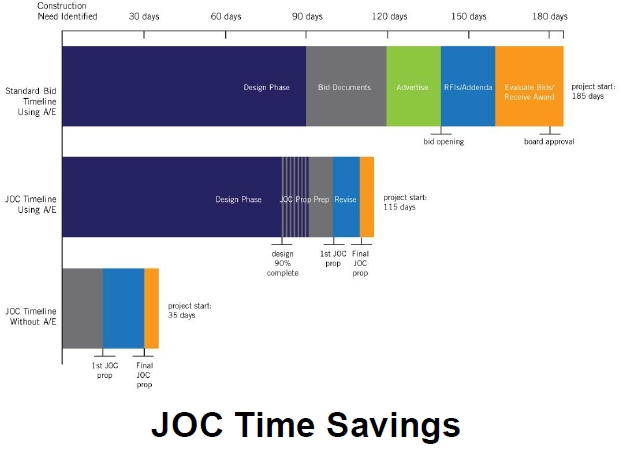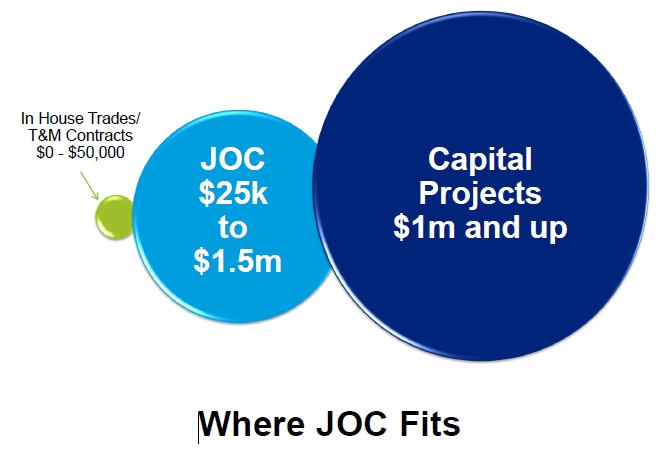The follow are excerpts from a RSMeans White Paper.
“Traditional construction delivery methods are fraught with problems. Architects and engineers spend countless hours attempting to design and specify their projects completely. Owners have reams of rules and regulations to follow in order to put a project out for bid fairly. Contractors spend millions of dollars attempting to be a low bidder. Our courts are tied up with case after case of “whose fault is it?” Job Order Contracting offers an alternative to traditional bidding processes. Based on industry-standard cost data and predefined processes that promote streamlining of project development, early contractor involvement, fewer change orders and higher quality construction, JOC is a refreshing change.”g
An innovative method of contract management is being used more and more by owners who desire quick service and reasonable cost.
“JOC is a proven, but innovative method of contract management being used more and more by owners who desire quick service and reasonable cost for the maintenance and repair of their facilities. The job order contracting method has found inroads with those owners who have multiple facilities to care for in multiple locations.”
The Origins of JOC
Job order contracting found its genesis in the complex facilities world of the United States military. Tasked with maintaining and repairing thousands of buildings nationally and internationally, military facilities managers found the normal route of federal acquisition regulations much too slow and bureaucratic. Out of the need to solve this problem was born the idea of having an agreed-upon database of construction costs for both owner and contractor. This database would be referenced for estimating, negotiating, project control and closeout.
Job order contracts, also known as Simplified Acquisition of Base Engineering Requirements (SABER), are types of Indefinite Delivery Indefinite Quantity (IDIQ) contracts used in the United States and internationally since 1985. Billions of dollars worth of construction have been completed under JOC contracts since that time.
The primary concern in JOC contracts is time. Federal acquisition regulations require a lengthy process of design, bidding and award for all contracts above a certain dollar amount. If, for example, a roof were leaking, the process of having it replaced could take anywhere from six to nine months. By using a JOC contract, the amount of time could be reduced to as little as six to nine weeks. The use of this type of contract has been authorized by the Federal Acquisition Streamlining Act (FASA)1 for just this reason.
Secondary to time is price and quality. Goals for JOC contracts are increasing the quality level of work performed, as well as keeping costs down. Secondary goal attainment is enhanced due to the nature of the contract. The contractor is motivated to perform quality work at a reasonable cost by the promise of continued work orders and potential extension of the contract to option years.
Advantages and Disadvantages of JOC
Independent studies have shown that the use of JOC will decrease the amount of time from job order identification to completion. The decrease in time is largely due to reduced design and procurement time. Most JOC job orders can be executed with streamlined design documents. This combination of limited design and decreased time has resulted in cost savings to the owner over traditional methods of contracting.
The actual work performed in a JOC contract is often subcontracted, enhancing opportunities for minority and women-owned businesses and allowing some small companies to get their first opportunity to do government work.
Long term dependable relationships between owners and contractors can be developed. The contractor is motivated by the contractual arrangement to perform at a high level, so more work will be made available. This enables the contractor to earn a profit over many jobs rather than one at a time and incentivizes a contractor to serve the customer effectively with high quality work in order to win additional job orders. These factors have led to increased quality in construction.4
The primary disadvantage of Job Order Contracting is the learning curve for both owners and contractors implementing JOC for the first time. Learning the project development process and line item estimating methodology is a necessary investment for a successful JOC program, and appropriate training and support such as that provided by consultants like RSMeans is critical. Some owners can also encounter resistance from the contracting community when JOC is perceived as reducing the quantity of contract opportunities. This challenge can be addressed through appropriate contractor outreach and education and through the careful structuring of a JOC program to maximize opportunities for small and disadvantaged businesses, whether as prime or subcontractors.
via http://www.4Clicks.com – Premier cost estimating and efficient project delivery software solutions for JOC, SABER, IDIQ, MATOC, SATOC, MACC, POCA, BOA, BOS … featuring an exclusively enhanced 400,000 line item RSMeans Cost Database, visual estimating/automatic quantity take off ( QTO), and collaborative contract/project/document management, all in one application. Our technology is currently serving over 85% of United States Air Force bases and rapidly growing numbers of other DOD and non-DOD (United States Army Corps of Engineers, Army, GSA, Homeland Security, VA..) federal departments/agencies, as well as state/county/local governments, colleges/universities, healthcare, and airports/transportation. RSMeans
Strategic Partner





